Neuberger Museum of Art (original) (raw)
Current Exhibitions
Stephen Antonakos: Proscenium
On view now
Named for a type of Greek stage, Proscenium — created in 2000 by light artist Stephen Antonakos — animates the vast, darkened space of the Museum’s Theater Gallery with vibrant, saturated color, glowing light, and calligraphic line.
Antonakos (1926–2013) was a pioneer in the use of neon as a fine art. In a career that spanned over five decades, he created illuminated works for indoor rooms and outdoor spaces around the world including the United States, Greece, Japan, Germany, France, and Israel. As the artist observed, “For me neon is not aggressive, but it has certain powers. I simply thought so much more could be done with it abstractly than with words and images. I had a feeling that it could connect with people in real, immediate, kinetic, and spatial ways.”
Antonakos’s neon installations are classic studies in light, space, and form. Using a simple, minimal vocabulary of straight and undulating lines and incomplete circles and squares, his luminous environments are both tangible and transcendent. According to Antonakos, “Visual experience is inner experience. What I hope to do is offer access to a more intense, heightened kind of experience. One that is more conscious, more open.” Of course, the essence of this experience is light, which from time immemorial has been associated with spirituality and the divine presence.
The formal, radiant beauty of Proscenium evokes this mystical relationship.
Stephen Antonakos: Proscenium is organized by the Neuberger Museum of Art, Purchase College, SUNY. This monumental site-specific neon installation was commissioned for the Museum twenty-five years ago. Generous support for this exhibition is provided by the Friends of the Neuberger Museum of Art.
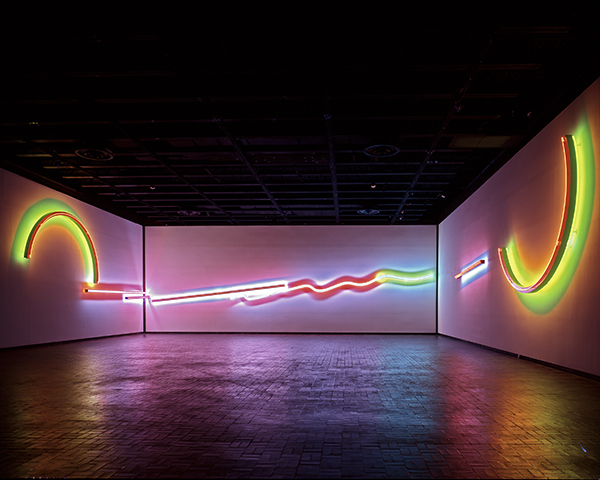
Stephen Antonakos; Proscenium, 2000; Neon and painted raceways; Overall dimensions: 20’6” x 189’; Collection Friends of the Neuberger Museum of Art, Purchase College, State University of New York; Museum purchase with funds provided by Mr. and Mrs. Stefan D. Abrams, EL 02.2001.01; Art: © Stephen Antonakos Studio, LLC., Photo: © Jim Frank
Janet Langsam: Improbable Feminist
April 2 - June 29, 2025
It was great being featured in The New York Times…but I really didn’t care for the headline. I mean, really… “A Day in the Life of Nonstop Housewife”? Here I was, a leader in the community, exhibiting my artwork, teaching…. That headline framed everything I was doing—everything I was—within the context of being a housewife. I was a housewife, and proud of that part of my life, but it was just one part of my life.
Married with three kids, living in Queens and keeping house, inspiration came to Janet Langsam one day as she was picking up her children’s toys. Unlike most of us who have picked up our children’s toys and binned or shelved them, wishing our children would learn to do that for themselves, on this day Langsam picked up the toys, put glue all over them, adhered them to a backboard, and covered them in paint.
By the time the article, “A Day in the Life of Nonstop Housewife” was published on January 15, 1972, Langsam was making paintings, assemblage, sculpture, collages, and drawings, working small in her house in Queens and large in the gymnasium of an old schoolhouse that she and her husband bought upstate and were converting. She was showing her work at the time of the article in a group exhibition at a New York University gallery in Greenwich Village. She was chairing Queens Community Board 7. She was teaching painting to schoolchildren.
In the 1970s and 1980s, very few women were able to succeed as professional artists. Gallery representation was almost impossible to come by for women and, therefore, they had few opportunities to exhibit and sell their work. Correspondingly, by the mid-1970s, Langsam shifted away from making her own art to working on what she refers to as a “larger canvas,” making sure that people had access to art, and making sure that artists had funding to make art. Janet Langsam: Improbable Feminist surveys the artist’s body of work from its inception to the point at which she redirected her efforts toward making the world a better place through art. It is a story told in the exhibition through the artist’s own words.
Janet Langsam: Improbable Feminist is organized by the Neuberger Museum of Art. Generous support for this exhibition is provided by the Friends of the Neuberger Museum of Art.
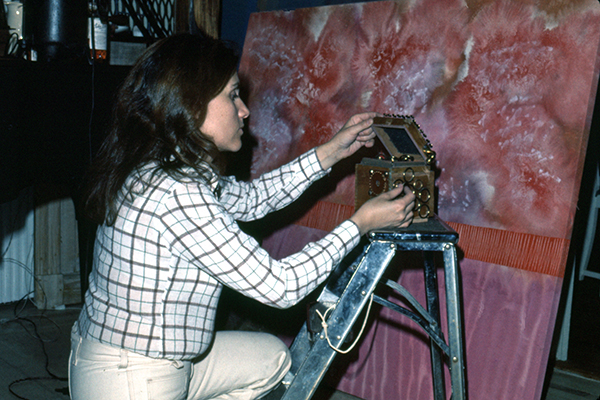
Janet Langsam: Improbable Feminist
Liminal in Nature
On view now
Liminality is what one might think of as an intermediate, transitional, or in-between state of being. Deriving from the Latin word “limen,” it roughly translates to a threshold. Something liminal in nature is on the threshold of change – not quite before, not quite after, but a fluid, in-between of its own –existing between two or more points of reference.
All things made of matter—wood, clay, stone, and even the human body—are inherently liminal, and constantly changing, whether it’s immediately noticeable, or shows its transition over a period of time. A liminal space can capture change across various scales, easily detectable by the human eye in some, and understood on a microscopic scale in others. A fluid threshold can create space for physical changes, or psychological ones—or a combination of both. Regardless of what is occurring within a liminal space, the beauty is its inability to be confined to singularity.
Artists working in sculpture often work with materials and formal elements in ways that feel liminal. Sculpture has always had a complicated relationship with its definition, and its artists have leaned into how it restructures and questions boundaries. These artists balance preserving the original form of their materials, while also manipulating and creating anew. Sculpture also challenges the viewer’s placement, forcing us to experience it as a multi-dimensional and multi-faceted object in our world, interacting with our bodies directly. Depending on where we position ourselves, the work “changes,” looking and feeling different as we move. If sculpture relies on a fluid viewing experience, where does it truly end, or begin? How does our physical and psychological movement help us identify, or cast out, parts of ourselves? Is there truly a concrete boundary between “self” and “other”
We understand ourselves best by observing and connecting to our external environment. Humans have a complex history of empathizing with the natural world; as we change, it changes, too. Liminal in Nature allows visitors to channel the intuitive sense of their own bodies, and form personal interrelationships between themselves and the art. The exhibition serves as a reminder that our perceptions, experiences, and identities, are constantly in flux, affecting who we are, and how we interpret not only ourselves and others, but also the natural world.
Liminal in Nature is organized by the Neuberger Museum of Art and curated by Curatorial Assistant Rebecca Elisabeta Marya (Rem) Ribeiro.
Generous support for this exhibition is provided by the Friends of the Neuberger Museum of Art.
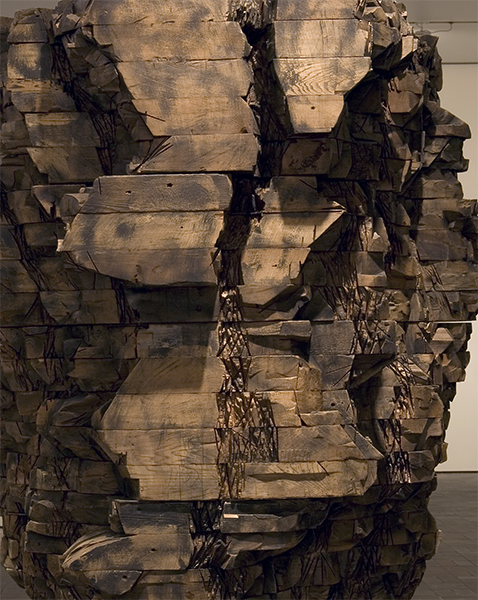
Ursula von Rydingsvard, Bowl with Side Steps (detail), 2002; Cedar and graphite; 83.5 x 70 x 69 in. (212.09 x 177.8 x 175.26 cm). Collection Friends of the Neuberger Museum of Art, Purchase College, SUNY. Museum purchase with funds from Neuberger Berman partners Michael W. Kamen, Beth Nelson, and Heidi L. Steiger in honor of Roy R. Neuberger’s 100th Birthday, EL 03.2004.01 Art: © 2025 Ursula von Rydingsvard / Artists Rights Society (ARS), New York). Photo: © Jim Frank.
Molten Metals
On view now
For centuries, artists have pushed the boundaries of metalwork, using heat, force, and ingenuity to shape this powerful medium into stunning works of art. Whether conforming to industrial aesthetics or defying them, their metallic creations embody the dynamic relationship between the organic elements of nature and the precise geometry of modern man-made industrialism.
Molten Metals highlights standout works from the Neuberger Museum of Art’s permanent collection, showcasing a range of techniques. Beverly Pepper’s Model for Split Pyramid demonstrates welding, where segments of Corten steel are permanently joined with heat. Harry Bertoia’s Construction (Radiant) uses soldering—a similar process that bonds metal parts with an alloy. Dorothy Dehner’s Long Landscape exemplifies casting, where molten bronze is poured into a mold and cooled to form a single unified shape.
The results are both organic and geometric, fluid and precise. Nancy Graves and Ann Sperry channel natural forms like flora and fauna, while Wendy Ross and Beverly Pepper lean toward molecular, minimalist designs. Each work explores the evolving possibilities of metal, transforming industrial techniques into something unexpectedly beautiful.
Organized by the Neuberger Museum of Art, Molten Metals celebrates the artistry of transformation. This exhibition is generously supported by the Friends of the Neuberger Museum of Art.
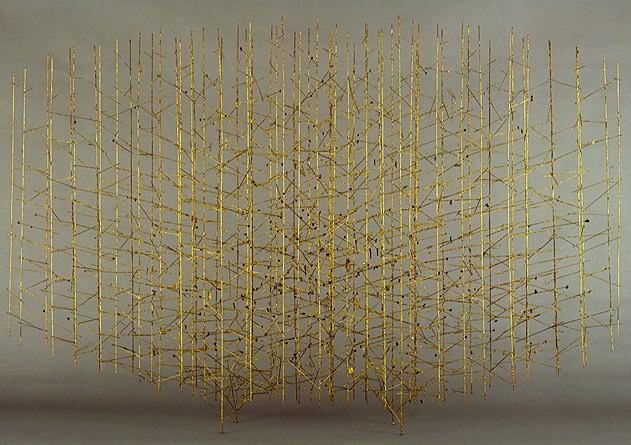
Harry Bertoia, Construction (Radiant), 1958. Copper and steel; 45 x 67.5 x 8 in. (114.3 x 171.5 x 20.3 cm). Collection Neuberger Museum of Art, Purchase College, SUNY. Gift of Roy R. Neuberger. 1979.10.07. © 2025 Estate of Harry Bertoia / Artists Rights Society (ARS), New York. Photo: Jim Frank
Upcoming Exhibitions
Petah Coyne: How Much A Heart Can Hold
Spring 2026
Petah Coyne: How Much A Heart Can Hold marks the museum debut of several new works by sculptor Petah Coyne and is both a multi-decade exploration of her career and an ode to women’s complexity and creativity.
In her complex, detailed, fantastical sculpture Coyne often celebrates under-recognized female authors and Eastern literary figures. Her works rise from the writers and characters; dissect their complex stories; and examine how relationships, social constructs and self-image can shape how women—real and fictional—experience and navigate the world. The exhibition features sprawling sculptural works made of cloth, hair, scrap metal, wax, silk flowers and other unorthodox materials. Visitors will also see The Real Guerrillas: The Early Years. The project is an ongoing collaboration with artist Kathy Grove to photograph the Guerrilla Girls, an anonymous artist activist group that formed in New York in 1985 to expose gender and ethnic bias in art and culture.
The exhibition’s three sections—“Women’s Work,” “Women Obscured and Transformed” and “Women’s Relationships”—present a broad view of Petah Coyne’s artistic practice while honoring the literat5ure and the literary figures she loves. A line by Zelda Fitzgerald inspired the exhibition title. “Nobody has ever measured, even the poets, how much a heart can hold,” the American writer, dancer and painter wrote in an unpublished manuscript.
Petah Coyne: How Much A Heart Can Hold is organized by the Chazen Museum of Art, University of Wisconsin-Madison.
Generous support for the organization of this exhibition was provided by Stephen and Pamela Hootkin, and the Anonymous Fund.
Generous support for the Neuberger Museum of Art’s presentation of Petah Coyne: How Much a Heart Can Hold has been provided by ArtsWestchester with funding made possible by Westchester County government with the support of County Executive George Latimer.
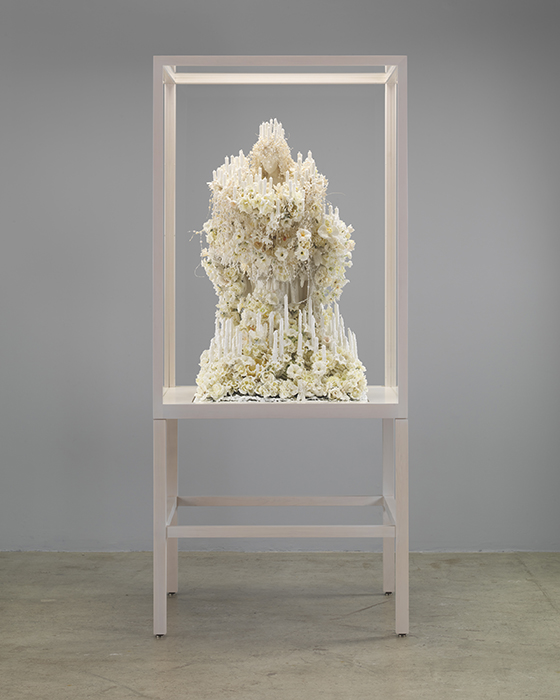
Petah Coyne; Untitled #1378 (Zelda Fitzgerald), 1997–2013; Specially formulated wax, pigment, silk flowers, candles, paint, white pearl-headed hat pins, artficial pearl strands, cast-wax statuary figure, cast-wax hand sculptures, ribbon, knitting needles, steel rods, chicken-wire fencing, washers, fabric, thread, wire, horse hair, Masonite, plywood, drywall, plaster, glue, filament, rubber, steel, wood and metal screws, maple,laminated Luxar; 81 3/16 x 35 3/4 x 35 3/4 in. (206.2 x 90.8 x 90.8 cm); Joen Greenwood Endowment Fund purchase, 2018.39a-b; Photo credit: Christopher Burke Studios
Guerrilla Girls: 40 Years Ago
Spring 2026
Forty years ago, in response to the exhibition An International Survey of Recent Painting and Sculpture at the Museum of Modern Art, New York, in which only thirteen of 165 artists were female-identifying, a group of artists and creative minds birthed an anonymous collective to call attention to art-world inequities.
The collective’s name—the Guerrilla Girls—was inspired by war tactics devised to be irregular, sudden, and often shocking. In their work, each “Girl” adopted anonymity in two ways. First, they assumed the name of female creatives from the past, such as Gertrude Stein, Artemisia Gentileschi, and Zora Neale Hurston, thus giving “new” voice to creative women throughout history. Second, they donned gorilla masks, inspired by an accidental misspelling of the word “guerrilla.”
Over the past forty years, the Guerrilla Girls have protested various forms of corruption through mass-produced works featuring simplistic, yet eye-capturing typography, bright contrasting colors, loaded infographics, and their signature rhetorical and sardonic language. They have extended their message internationally through actions and exhibitions. While their origins stemmed from the art world, their agenda has since expanded to critique sexism, homophobia, and racism in areas such as film, mass culture, economics, and politics, to name a few.
Featuring work from their earliest years, drawn from the Guerrilla Girls Portfolio Compleat, 1985–2021, the exhibition Guerrilla Girls: 40 Years Ago highlights their iconic beginnings, almost half a century ago, examines the Girls’ earliest concerns with the art world, and allows us to see not only what has changed since then, but also where true progress has yet to be made.
Guerrilla Girls: 40 Years Ago is curated by Curatorial Assistant Rebecca Elisabeta Marya Ribeiro and fall 2024 curatorial interns Cameron Drury, Letizia Franzese, and Bow Young, and organized by the Neuberger Museum of Art. Generous support for this exhibition is provided by the Friends of the Neuberger Museum of Art